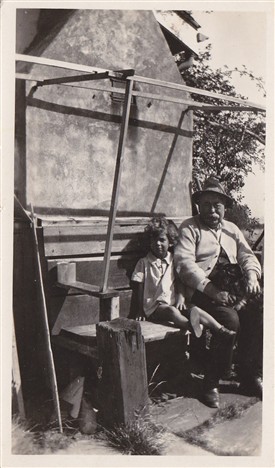Ralph Chapman - A Rochford Life

Ralph Chapman and his grandfather
Although I spent most of my life in Essex, I was born in Bethnal Green in 1927, a place I knew as “Rebels Country” due to it having been a focal point for numerous protests and demonstrations (e.g. Victoria Park). I lived in East London for a few years before moving further east, to Essex.
My younger brother, Lawrence, was born on 5th May 1945 (VE day) and I was born at precisely 11.11am on 11th November 1927; because of this, he and I were known locally as “the Victory kids”.
My father was Ralph Herbert Chapman and I am from a long line of builders: on my father’s side were the non-trade unionists who didn’t employ specialists, while my mother’s side (the Hoskings) were the largest public works contractors in the Bethnal Green area and were union-controlled. When the two firms united, they were able to benefit one another. In particular, the merged firm was better able to do what is called “snagging”, the term used for completing a job using non-skilled workers. It was cheaper, of course, to have a jobbing builder go in at the end of a job to do the touching-up work than to have this done by a professional tradesman.
My great-grandfather (Pelly) was a freeman of the City of London and my father designed and built the Barbican.
Eventually, I became the director of Hoskins Builders and I worked in the family firm for many years.
The last job I did with Hoskins was the Mill Hall at Rayleigh. Hoskins Builders have the distinction of being the builders of the radio stations at Canewdon and Hornchurch, amongst many other projects. I am proud of the work that I did, and the skills that I have been able to pass on to future generations of public works builders.
Education
I began attending Ashingdon Primary School when I was 5 years old. My teacher was Miss Rolph and I remember helping ring the bell to signal the end of break, etc. I also remember using slate and chalk rather than pencil and paper. After school, I gained a scholarship to Mid Essex Technical College (now the Anglia Ruskin University).
Although my parents and my headmaster wanted me to go into academia, I quickly realised that it wasn’t for me. The Mid Essex Technical College was the only place outside London which offered a course in building, and I began studying there in 1941/42. It was the right decision, as I took every prize in the group. I was far more interested in building than academic study.
During my career, I was involved in the construction of, amongst other buildings, Princes Avenue School and the first pub, church, school and factory in Basildon new town.
After my apprenticeship, I taught part-time at Southend College and eventually became head of department there.
It seems to me that many skills involving craftsmanship and dexterity are overlooked. My old department in London Road has been demolished and computer studies are taught more frequently than building courses.
In my experience, education does not always get the best out of children by keeping them in academia for too long. Also, it does not place sufficient emphasis on practical skills.
Early Life and World War II
I was in the 1st Hawkwell Scouts (led by Reverend Trudgett, the vicar of Hawkwell parish). I did “spadework” at Belchamps, the scout HQ and eventually became a patrol leader with my best friend, Michael Ford. He was the son of the headmaster of Ashingdon School, Cecil G Ford.
Cecil Ford was also a Captain in the Ashingdon Unit of the Home Guard (Dad’s Army), which used Ashingdon School as its HQ.
On VE Day, there were celebrations across the whole country. Bonfires were lit in the grounds of Ashingdon Hall, as part of the beacons which illuminated the whole country on that night. I also remember Dunkirk evacuees being taken into Rochford.
The Rochford area
A record of footpaths in the district was made by a Chapman. It does not, however, include bridleways. There was a major bridleway from Pulpits Farm to the shop in Ashingdon, which has degenerated. A doctor’s surgery is being built across it at one end, and it is very narrow in parts. Many local rights of way have been, or are being, lost. Another example of this is the bridleway along which people used to take horses to be shod at the smiths at Trinity Wood Road, which is now a private road.